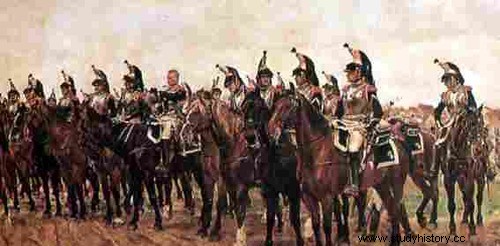September 16, 1777 (Caulaincourt) - September 7, 1812 (the Moskva)
-

- Caulaincourt
Younger brother of the marquis, Caulaincourt follows the same path and also finds himself aide-de-camp to Aubert-Dubayet in 1795. He is then employed on the Rhine in the cavalene, makes the campaign of Helvetia in 1799, fights against the Russians in front of Zürich. Masséna appointed him squadron leader soon after. Aide-de-camp to Louis Bonaparte in 1804 and leader of the dragoon brigade, he served at Austerlitz before entering the service of the King of Holland in 1806. Grand squire and aide-de-camp to King Louis, Major General, Minister Plenipotentiary of Holland in Naples , he rejoined the French army as a brigadier general in 1808, was made a baron of the Empire and sent to Spain. He took Cuenca on July 3, 1808, fought several battles, was made general of division in September 1809 and placed at the head of all the dragoon regiments in Spain. Returning to France in 1810, he was part of the Grande Armée and followed it to Russia in 1812, where he was killed by a ball during the assault on the great redoubt at the Moskva. His name appears on the east side of the Arc de Triomphe.
Murat's idea?
Soldiers of the Grand Army - Perrin, 1998 - JC Damamme
Wacky in appearance and simple:it is the cavalry that will take the redoubt.
First flabbergasted then conquered which rider has never dreamed of an action of this kind, even if he could not believe it? -, Caulaincourt, at the moment of rushing at the head of his steel-lined colossi of the 5th, 8th and 10th cuirassier regiments and the two dazzling rifle regiments with gilded cuirasses of General Defrance, Caulaincourt, therefore, would have turned towards his riders, and saber raised high, would have cried out, to the attention of the officers still reeling from the loss of their leader:"Gentlemen, mourn no longer for Montbrun. We are going to avenge him." Then, without a glance behind, he rushes, the 5th cuirassiers on the hoofs of his horse. The regiment gallops. A Russian battalion at rest in a ravine is stabbed to the ground by the sabers of the horsemen.
Suddenly, in the confusion of men, horses, weapons, in the middle of smoke and cries, appears the famous gorge, the last way leading to the redoubt. Pressed against each other, the passage is so narrow, the iron men slip, surge into the bottleneck. At the top, a few Russian grenadiers, who thought they were safe, barely had time to grab their weapons when they collapsed, pierced right through - the blade of the cuirassier saber is 975 mm long! In a few moments, the impregnable redoubt, invested, is nothing more than a charmer.
While this prodigy was taking place, Prince Eugene, at the head of his infantry, attacked...
Suddenly, while in the ranks of the infantry, everyone expects to suffer the fate that we guess was that of the horsemen, a great silence falls. The Russian artillery suddenly loses its voice.
The infantrymen look up.
Surprise ! On the parapets sparkle helmets, breastplates and sabers. The 5th Cuirassier Regiment has just captured the redoubt.
In the cloud of dust which was slowly dissipating, amidst the corpses of men and horses, Auguste de Caulaincourt was raised. He had been shot in the chest. He joined the Lasalles and other Montbruns in their legend. A composition by the painter Lalauze shows Caulaincourt, carried by four cuirassiers on a torturous path. The survivors present their arms to him. The image is very beautiful and why not write it, moving. An artillery officer. who witnessed the gesture, wrote:"It would be difficult to form an idea of what we felt at the sight of this brilliant feat of arms, perhaps unexampled in the military splendor of nations."
